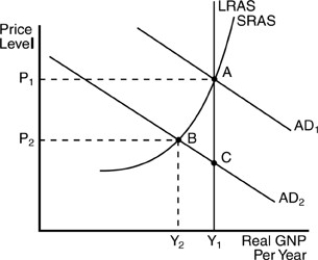Multiple Choice

-In the above figure, start with the economy in equilibrium at point A. Then an unanticipated reduction in aggregate demand triggers a shift from AD₁ to AD₂. In the short run, this would cause
A) the price level to fall from P₁ to P₂, real Gross Domestic Product (GDP) to fall from Y₁ to Y₂, and the rate of unemployment to increase.
B) the price level to move from P₁ to P₂, but real Gross Domestic Product (GDP) would stay at Y₁.
C) the price level to fall by some amount less than P₁ but greater than P₂, and the rate of unemployment would decrease.
D) no change in either the price level or real Gross Domestic Product (GDP) , but a decrease in unemployment.
Correct Answer:

Verified
Correct Answer:
Verified
Q3: The Phillips curve shows the relationship between<br>A)
Q77: The idea that anticipated monetary policy cannot
Q84: The U.S. economic data for the last
Q114: The longer is the interval between firms'
Q148: The stagflation experienced in the U.S. during
Q177: An unexpected decrease in aggregate demand<br>A) causes
Q230: Which of the following holds that economic
Q237: If a significant portion of firms in
Q265: The idea of policymaking taking place in
Q286: The inflation rate has been constant for